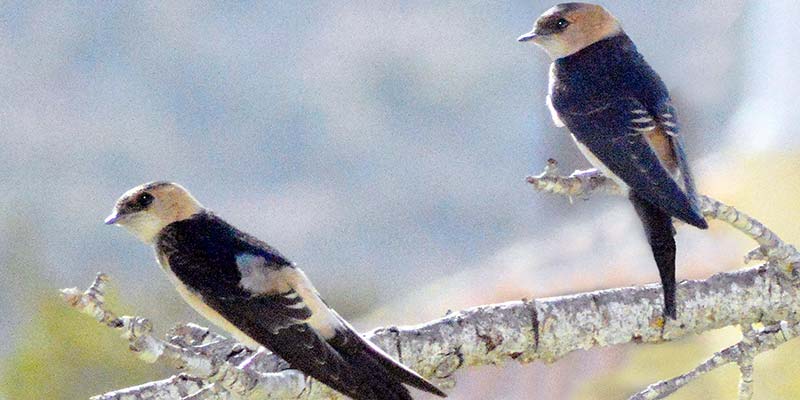This time last year I was proudly crowing about the birth of four red-rumped swallows. Their nest, constructed around the chain of an outdoor chandelier, was located just outside our living room window. I was so boastful about the chicks you’d think that I had hatched them by myself.
At every opportunity I referred to these attractive birds informing people that they were rarer than a common swallow. I felt, as if by living in the tranquil surroundings of the Loulé hills, I was in some way contributing to their upbringing. I reveled in the navigational skills of the parent birds explaining to anyone who would listen that every spring they make an epic journey from sub-Saharan Africa in order to breed in the Algarve.
In autumn as expected, the parents and their youngsters set off south to their winter home. After several months of watching them, I could only hope that I might see some of them again the following spring. I did, it was in April when the pair returned and took up residence again in the nest. Mating took place inside the privacy of their living quarters – a habit that all red-rumped swallows adopt – the eggs were laid and hatched, and the parents enthusiastically fed their young.
But nature brought about the cruelest turn of fate when a pair of sparrows decided to raid the nest. They threw out the chicks that were still too young to fly and with determined aggression saw off the parent birds who, to my dismay, were not seen again.
To say I was furious with the sparrows is an understatement and, adding insult to injury, they chirruped loudly on the metal chandelier announcing that this was now their territory. It became obvious that they had taken up squatter’s rights and intended to inhabit the nest. Being rather elitist about birds, I was not impressed to have a pair of common or garden sparrows in residence on the terrace. Murderous sparrows at that!
Over the next few days, they proceeded to furnish their newly-acquired nest with dry grasses and feathers. Their DIY skills seemed poorly developed as they dropped copious quantities of debris on the terrace floor. Compared to the red-rumped swallows who had built the nest from scratch using mud and saliva, the sparrows’ idea of home-making was an untidy business.
So too were their acrobatics as they attempted to indulge in sparrow rumpy-pumpy. This was done on the swinging chandelier giving new meaning to the expression, ‘a couple of swingers’. When it came to the act of copulation, they lacked the discretion of the red-rumped swallows.
Two weeks elapsed and on hearing feeble cheeps coming from inside the nest, I realized the sparrow chicks had hatched. Now there were hungry mouths to feed and the parent birds, their beaks bulging with every sort of invertebrate, dutifully got on with the task. Rummaging through bark chippings that form our winding garden paths was an excellent source of grubs and creepy crawlies. Catching insects on the wing was another source of protein.
At this point, I should tell you that no insecticides or chemicals have been used to treat the fields around our house. Wild thyme grows in profusion and where there are almonds and olives, the farmer ploughs around the trees. Known as green manure, it enriches the soil by returning grasses, clovers, vetches and other naturally growing plants into the ground. This method does not damage the environment and ensures that invertebrates can continue to live harmoniously in nature.
Unlike many other sparrows – whose numbers are in serious decline – our chicks were receiving protein-rich food, an absolute necessity for young birds in their first 18 days of life. Seeds, nuts and berries won’t do. The main course on the menu has to be invertebrates. Although our chicks were being brought up in a squat, their diet was Michelin starred. As they developed, so too did their voices, noisily calling out for more food and rapid service.
One day – when I happened to be wondering about the red-rumped swallows and if they had successfully reared some young – I came across a magazine article outlining the plight of Iberian sparrows. A survey conducted by Amparo Herrera-Dueñas of Madrid University concluded that both rural and urban sparrows are under stress. Taking into account contributory factors such as the use of insecticides, air pollution and poor diet, it is especially during the breeding season that parents are put to the test. Our adult sparrows worked extremely hard to feed their brood but, unlike many others, they were fortunate to find the larder full.
As quickly as they arrived, the sparrow family disappeared. I didn’t see them go but one morning, when all was silent, I deduced the chicks had fledged. Unlike the red-rumped swallow chicks that stayed close to the house and roosted in the nest for two weeks after their first tentative flights, I never saw the sparrows again. In fact, I never knew how many chicks were reared. From loathing their parents at the start, I grew to respect their instincts. Feeding their offspring from dawn to dusk, the birds that had murdered the red-rumped swallow chicks gave their own offspring tender nurture.
Across Europe, there are now 150 million fewer sparrows than there were 30 years ago and, from my observations, this is certainly not due to parental neglect. In another 30 years, if we fail to tackle the damage we are doing to the environment, sparrows will become as rare as red-rumped swallows are today.
By Carolyn Kain
Photos: Peter Kain
























